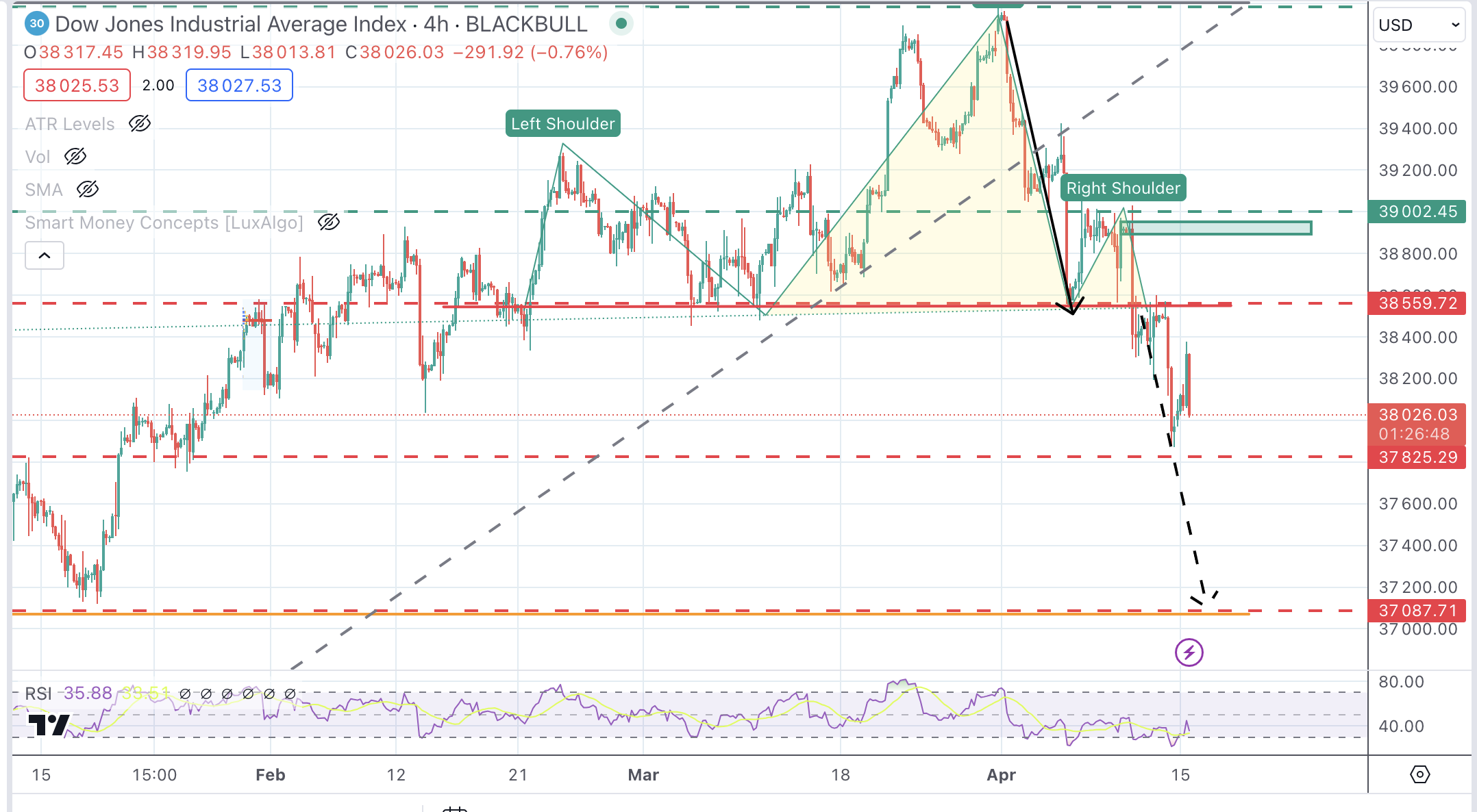- Dow Jones index is practically flat on afternun trading after having given away early gains.
- High yields and concerns about an escalation of the Middle East conflict have offset the upbeat quarterly results by Goldman Sachs.
- The technical picture remains bearish with DJIA drifting away from March high.
The Dow Jones Industrial Average (DJIA) is trading with marginal gains in the early afternoon after opening the week in green. Better than expected quarterly results by Goldman Sachs boosted risk appetite at the session opening although market sentiment soured as US Treasury yields rallied, following US Retail Sales data. Beyond that, investors remain wary as Israel debates its options to retaliate against Iran, which is weighing on risk appetite further and, crushing demand for equities.
Retail Sales data from the US has beaten expectations, confirming the strong momentum of the US economy. This is positive for market sentiment, although its consequences for monetary policy push back on hopes of interest rate cuts by the Federal Reserve (Fed), creating negative pressure on stocks.
Against this backdrop, most, Wall Street indexes have swung into negative territory. The NASDAQ is leading losses with a 1.65% decline to 15,912, followed by the S&P 500 which is 1.10% down at 5,067 and the Dow Jones, with a 0.6% decline to 37,750.
Dow Jones news
Most of the Wall Street sectors are in red on Monday afternoon trading, Real Estate leading losses with a 1.8% decline, followed by Technology, which is losing 1.72% and Communication Services, 1.63% down. Only the Health sector escapes from a broad-based decline, trading practically at opening levels.
Goldman Sachs (GS) is leading gains on Monday with a 2.65% rally to $399.85, followed by United Health Group (UNH), which rises 1.51% to $445.75. On the losing end, Salesforce (CRM) drops 6.73% to $274.36 as news reports suggest that the software firm is in talks to acquire Informatica. next is Apple (AAPL), 2,11% down to $172.89.
Dow Jones technical outlook
The technical picture shows bears in control as the Dow Jones index drifts away from the historic highs reached in March. The move below 38,560 has activated a bearish Head & Shoulders pattern that might hint toward a sharper decline.
The next bearish target is 37,825. Below here the measured target of the H&S pattern, which meets the mid-January low and 38.6% Fibonacci retracement, comes at 37,087. A bullish reaction should overcome the 38,540 to open the path toward 39,000 (order block).
Dow Jones Index 4 -Hour Chart

Dow Jones FAQs
The Dow Jones Industrial Average, one of the oldest stock market indices in the world, is compiled of the 30 most traded stocks in the US. The index is price-weighted rather than weighted by capitalization. It is calculated by summing the prices of the constituent stocks and dividing them by a factor, currently 0.152. The index was founded by Charles Dow, who also founded the Wall Street Journal. In later years it has been criticized for not being broadly representative enough because it only tracks 30 conglomerates, unlike broader indices such as the S&P 500.
Many different factors drive the Dow Jones Industrial Average (DJIA). The aggregate performance of the component companies revealed in quarterly company earnings reports is the main one. US and global macroeconomic data also contributes as it impacts on investor sentiment. The level of interest rates, set by the Federal Reserve (Fed), also influences the DJIA as it affects the cost of credit, on which many corporations are heavily reliant. Therefore, inflation can be a major driver as well as other metrics which impact the Fed decisions.
Dow Theory is a method for identifying the primary trend of the stock market developed by Charles Dow. A key step is to compare the direction of the Dow Jones Industrial Average (DJIA) and the Dow Jones Transportation Average (DJTA) and only follow trends where both are moving in the same direction. Volume is a confirmatory criteria. The theory uses elements of peak and trough analysis. Dow’s theory posits three trend phases: accumulation, when smart money starts buying or selling; public participation, when the wider public joins in; and distribution, when the smart money exits.
There are a number of ways to trade the DJIA. One is to use ETFs which allow investors to trade the DJIA as a single security, rather than having to buy shares in all 30 constituent companies. A leading example is the SPDR Dow Jones Industrial Average ETF (DIA). DJIA futures contracts enable traders to speculate on the future value of the index and Options provide the right, but not the obligation, to buy or sell the index at a predetermined price in the future. Mutual funds enable investors to buy a share of a diversified portfolio of DJIA stocks thus providing exposure to the overall index.
